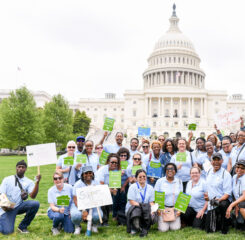Will the Sharing Economy Change Life Plan Communities?
Will future consumers of aging services shun ownership as they get more comfortable with the new “sharing economy” that’s gaining traction among millennials?
And how will life plan communities need to change so they can compete successfully in that economy?
Those are just some of the questions J. David Hoglund has been asking himself lately.
Hoglund, who is principal and director at Perkins Eastman in Pittsburgh, wonders if younger people in their 20s and early 30s will soon begin influencing what their parents will – and won’t – want to own in the future.
During a session called “Embrace the Disruptors: Trends Changing the Face of Senior Living” at this year’s PEAK Leadership Summit, Hoglund identified a few potential trends that could affect the design and planning of senior living.
More Rental Options
Millennials don’t see a need to own their own transportation when they can easily use a smart phone to borrow a Zip Car or rent a bicycle.
That desire for more rental options is spreading to other areas of the economy as people between the ages of 55 and 64 voice their preference for rental housing.
Hoglund attributes that desire to “the flexibility and the asset retention that rental brings,” and wonders if “this is something we need to think about in the future.”
Acceptance of Micro Living
Millennials are willing to work and live in smaller offices and apartments as long as they have access to shared space and other resources in the community, says Hoglund.
He wonders if this minimalist trend will bring micro units to senior living.
Fewer Cars
The success of ride-sharing services like Uber and Lyft could mean that fewer residents will be bringing their cars to life plan communities in the future. This potential trend prompted Hoglund to ask, “Are we planning garages and parking lots that we’re not going to need?”
And what about driverless cars? Hoglund envisions a future in which a driverless car could drop a resident at home after an excursion and then drive itself 5 miles from campus to a parking lot on lower priced land. Or, he wonders, maybe the car would simply go next store and pick up a fellow resident who shares that car.
Short-term Accommodations and Online Services
Hoglund named several emerging companies that life plan community executives should be watching as potential new models for service delivery.
For example, a new venture called Room2Care lets older consumers rent a room and care services in the same way they might rent an Airbnb accommodation.
“Are we going to see anything in our housing stock that will look like this?” asks Hoglund. “Will it offer older consumers the chance to go to Florida for a month because they can get services for a spouse?”
In addition, the new TaskRabbit service lets consumers use their computers to hire someone to help them tackle home improvement projects and repairs. Hoglund wonders if this and other “handyman” services will be “part of or a competitor to the Village Movement.”
Food for Thought
Hoglund admitted that much of his information about the impact of the sharing economy is anecdotal. But that doesn’t make the trends any less intriguing, he said.
“I think there is no question that these early pieces of the shared economy are going to impact the way we think about (life plan communities), not maybe in a full-blown way but certainly in some incidental ways,” said Hoglund. “These are the things that we need to keep an eye on as we look into the future.”

Most Recommended
April 30, 2024
How Are Your Communities Powered by Connection?
April 26, 2024
 Final Nursing Home Staffing Mandate: Analysis
Final Nursing Home Staffing Mandate: Analysis
Recently Added
May 08, 2024
House Marks Up Telehealth Act and Other Extensions
May 08, 2024



